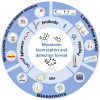Recent Progress in Rapid Determination of Mycotoxins Based on Emerging Biorecognition Molecules: A Review
- PMID: 35202100
- PMCID: PMC8874725
- DOI: 10.3390/toxins14020073
Recent Progress in Rapid Determination of Mycotoxins Based on Emerging Biorecognition Molecules: A Review
Abstract
Mycotoxins are secondary metabolites produced by fungal species, which pose significant risk to humans and livestock. The mycotoxins which are produced from Aspergillus, Penicillium, and Fusarium are considered most important and therefore regulated in food- and feedstuffs. Analyses are predominantly performed by official laboratory methods in centralized labs by expert technicians. There is an urgent demand for new low-cost, easy-to-use, and portable analytical devices for rapid on-site determination. Most significant advances were realized in the field bioanalytical techniques based on molecular recognition. This review aims to discuss recent progress in the generation of native biomolecules and new bioinspired materials towards mycotoxins for the development of reliable bioreceptor-based analytical methods. After brief presentation of basic knowledge regarding characteristics of most important mycotoxins, the generation, benefits, and limitations of present and emerging biorecognition molecules, such as polyclonal (pAb), monoclonal (mAb), recombinant antibodies (rAb), aptamers, short peptides, and molecularly imprinted polymers (MIPs), are discussed. Hereinafter, the use of binders in different areas of application, including sample preparation, microplate- and tube-based assays, lateral flow devices, and biosensors, is highlighted. Special focus, on a global scale, is placed on commercial availability of single receptor molecules, test-kits, and biosensor platforms using multiplexed bead-based suspension assays and planar biochip arrays. Future outlook is given with special emphasis on new challenges, such as increasing use of rAb based on synthetic and naïve antibody libraries to renounce animal immunization, multiple-analyte test-kits and high-throughput multiplexing, and determination of masked mycotoxins, including stereoisomeric degradation products.
Keywords: antibodies; aptamers; biosensor; lateral flow assay; microplate assay; molecularly imprinted polymers; multiplexing; mycotoxins; rapid tests; short peptides.
Conflict of interest statement
The authors declare no conflict of interest.
Figures









Similar articles
-
Advances in Biosensors, Chemosensors and Assays for the Determination of Fusarium Mycotoxins.Toxins (Basel). 2016 May 24;8(6):161. doi: 10.3390/toxins8060161. Toxins (Basel). 2016. PMID: 27231937 Free PMC article. Review.
-
Bioinspired recognition elements for mycotoxin sensors.Anal Bioanal Chem. 2018 Jan;410(3):747-771. doi: 10.1007/s00216-017-0701-3. Epub 2017 Nov 10. Anal Bioanal Chem. 2018. PMID: 29127461 Review.
-
Enhancing mycotoxins detection through quantum dots-based optical biosensors.Nanotechnology. 2024 Nov 7;36(4). doi: 10.1088/1361-6528/ad8c4d. Nanotechnology. 2024. PMID: 39508269 Review.
-
Recent Advances in Recognition Receptors for Electrochemical Biosensing of Mycotoxins-A Review.Biosensors (Basel). 2023 Mar 17;13(3):391. doi: 10.3390/bios13030391. Biosensors (Basel). 2023. PMID: 36979603 Free PMC article. Review.
-
Progress and challenges in sensing of mycotoxins using molecularly imprinted polymers.Environ Pollut. 2022 Jul 15;305:119218. doi: 10.1016/j.envpol.2022.119218. Epub 2022 Mar 29. Environ Pollut. 2022. PMID: 35364185 Review.
Cited by
-
Nivalenol Mycotoxin Concerns in Foods: An Overview on Occurrence, Impact on Human and Animal Health and Its Detection and Management Strategies.Toxins (Basel). 2022 Jul 31;14(8):527. doi: 10.3390/toxins14080527. Toxins (Basel). 2022. PMID: 36006189 Free PMC article. Review.
-
Ochratoxin A in food commodities: A review of occurrence, toxicity, and management strategies.Heliyon. 2024 Oct 12;10(20):e39313. doi: 10.1016/j.heliyon.2024.e39313. eCollection 2024 Oct 30. Heliyon. 2024. PMID: 39640601 Free PMC article. Review.
-
Fusarium mycotoxins: The major food contaminants.mLife. 2024 May 13;3(2):176-206. doi: 10.1002/mlf2.12112. eCollection 2024 Jun. mLife. 2024. PMID: 38948146 Free PMC article. Review.
-
Nanoscale Materials Applying for the Detection of Mycotoxins in Foods.Foods. 2023 Sep 15;12(18):3448. doi: 10.3390/foods12183448. Foods. 2023. PMID: 37761156 Free PMC article. Review.
-
Aspergillus Mycotoxins: The Major Food Contaminants.Adv Sci (Weinh). 2025 Mar;12(9):e2412757. doi: 10.1002/advs.202412757. Epub 2025 Feb 7. Adv Sci (Weinh). 2025. PMID: 39921319 Free PMC article. Review.
References
-
- Pleadin J., Frece J., Markov K. Advances in Food and Nutrition Research. Vol. 89. Academic Press Inc.; Cambridge, MA, USA: 2019. Mycotoxins in food and feed; pp. 297–345. - PubMed
Publication types
MeSH terms
Substances
LinkOut - more resources
Full Text Sources
Medical

